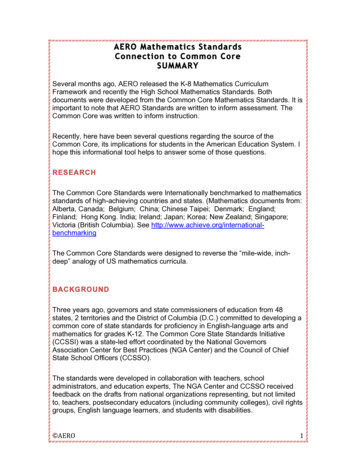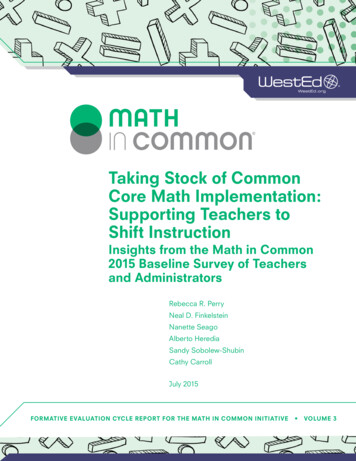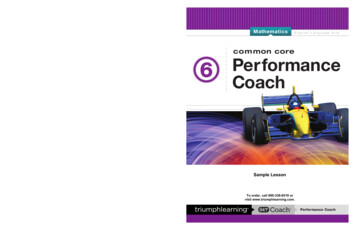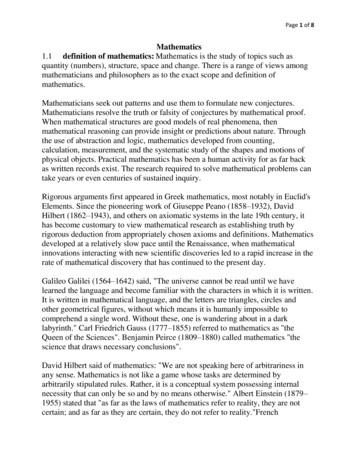
Transcription
!Mathematics, the Common Core, and Language: Recommendationsfor Mathematics Instruction for ELs Aligned with the Common CoreJudit Moschkovich, University of California, Santa Cruz1. IntroductionThis paper outlines recommendations for meeting the challenges in developing mathematicsinstruction for English Learners (ELs) that is aligned with the Common Core Standards. Therecommendations are motivated by a commitment to improving mathematics learning throughlanguage for all students and especially for students who are learning English. Theserecommendations are not intended as recipes or quick fixes, but rather as principles to help toguide teachers, curriculum developers, and teacher educators in developing their ownapproaches to supporting mathematical reasoning and sense making for students who arelearning English.These recommendations for teaching practices are based on research that often runs counter tocommonsense notions of language. The first issue is the term language. There are multipleuses of the term language: to refer to the language used in classrooms, in the home andcommunity, by mathematicians, in textbooks, and in test items. It is crucial to clarify how we usethe term, what set of phenomena we are referring to, and which aspects of these phenomenawe are focusing on. Many commentaries on the role of academic language in mathematicsteaching practice reduce the meaning of the term to single words and the proper use ofgrammar (for example, see Cavanagh, 2005). In contrast, work on the language of specificdisciplines provides a more complex view of mathematical language (e.g., Pimm, 1987) as notonly specialized vocabulary (new words and new meanings for familiar words) but also asextended discourse that includes syntax and organization (Crowhurst, 1994), the mathematicsregister (Halliday, 1978), and discourse practices (Moschkovich, 2007c). Theoretical positions inthe research literature in mathematics education range from asserting that mathematics is auniversal language, to claiming that mathematics is itself a language, to describing howmathematical language is a problem. Rather than joining in these arguments, I use asociolinguistic framework to frame this essay. From this theoretical perspective, language is asocio-cultural-historical activity, not a thing that can either be mathematical or not, universal ornot. I use the phrase “the language of mathematics” not to mean a list of vocabulary or technicalwords with precise meanings but the communicative competence necessary and sufficient forcompetent participation in mathematical discourse practicesi.It is difficult to make generalizations about the instructional needs of all students who arelearning English. Specific information about students’ previous instructional experiences inmathematics is crucial for understanding how bilingual learners communicate in mathematics Stanford University17!
!classrooms. Classroom instruction should be informed by knowledge of students’ experienceswith mathematics instruction, their language history, and their educational background. Inaddition to knowing the details of students’ experiences, research suggests that high-qualityinstruction for ELs that supports student achievement has two general characteristics: a view oflanguage as a resource, rather than a deficiency; and an emphasis on academic achievement,not only on learning English (Gándara and Contreras, 2009).Research provides general guidelines for instruction for this student population. Since studentswho are labeled as ELs, who are learning English, or who are bilingual are from non-dominantcommunities, they need access to curricula, instruction, and teachers proven to be effective insupporting academic success for this student population. The general characteristics of suchenvironments are that curricula provide “abundant and diverse opportunities for speaking,listening, reading, and writing” and that instruction “encourage students to take risks, constructmeaning, and seek reinterpretations of knowledge within compatible social contexts” (Garcia &Gonzalez, 1995, p. 424). Teachers with documented success with students from non-dominantcommunities share some characteristics: a) a high commitment to students' academic successand to student-home communication, b) high expectations for all students, c) the autonomy tochange curriculum and instruction to meet the specific needs of students, and d) a rejection ofmodels of their students as intellectually disadvantagedii.Research on language that is specific to mathematics instruction for this student populationprovides several guidelines for instructional practices for teaching ELs mathematics.Mathematics instruction for ELs should: 1) treat language as a resource, not a deficit (Gándaraand Contreras, 2009; Moschkovich, 2000); 2) address much more than vocabulary and supportELs’ participation in mathematical discussions as they learn English (Moschkovich, 1999, 2002,2007a, 2007b, 2007d); and 3) draw on multiple resources available in classrooms – such asobjects, drawings, graphs, and gestures – as well as home languages and experiences outsideof school. This research shows that ELs, even as they are learning English, can participate indiscussions where they grapple with important mathematical contentiii. Instruction for thispopulation should not emphasize low-level language skills over opportunities to activelycommunicate about mathematical ideas. One of the goals of mathematics instruction for ELsshould be to support all students, regardless of their proficiency in English, in participating indiscussions that focus on important mathematical concepts and reasoning, rather than onpronunciation, vocabulary, or low-level linguistic skills. By learning to recognize how ELsexpress their mathematical ideas as they are learning English, teachers can maintain a focus onmathematical reasoning as well as on language development.Research also describes how mathematical communication is more than vocabulary. Whilevocabulary is necessary, it is not sufficient. Learning to communicate mathematically is notmerely or primarily a matter of learning vocabulary. During discussions in mathematicsclassrooms, students are also learning to describe patterns, make generalizations, and userepresentations to support their claims. The question is not whether students who are ELsshould learn vocabulary but rather how instruction can best support students as they learn bothvocabulary and mathematics. Vocabulary drill and practice is not the most effective instructional Stanford University18!
!practice for learning either vocabulary or mathematics. Instead, vocabulary and secondlanguage-acquisition experts describe vocabulary acquisition in a first or second language asoccurring most successfully in instructional contexts that are language-rich, actively involvestudents in using language, require both receptive and expressive understanding, and requirestudents to use words in multiple ways over extended periods of time (Blachowicz and Fisher,2000; Pressley, 2000). In order to develop written and oral communication skills students needto participate in negotiating meaning (Savignon, 1991) and in tasks that require output fromstudents (Swain, 2001). In sum, instruction should provide opportunities for students to activelyuse mathematical language to communicate about and negotiate meaning for mathematicalsituations.The recommendations provided in this paper focus on teaching practices that aresimultaneously: a) aligned with the Common Core Standards for mathematics, b) supportstudents in learning English, and c) support students in learning important mathematicalcontent. Overall, the recommendations address the following questions: How can instructionprovide opportunities for mathematical reasoning and sense making for students who arelearning English? What instructional strategies support ELs’ mathematical reasoning and sensemaking skills? How can instruction help EL students communicate their reasoning effectively inmultiple ways?2. Alignment with Common Core State StandardsThe Common Core State Standards (CC) provide guidelines for how to teach mathematics forunderstanding by focusing on students’ mathematical reasoning and sense making. Here I willonly summarize four emphases provided by the CC to describe how mathematics instruction forELs needs to begin by following CC guidelines and taking these four areas of emphasisseriously.Emphasis #1 Balancing conceptual understanding and procedural fluencyInstruction should a) balance student activities that address both important conceptual andprocedural knowledge related to a mathematical topic and b) connect the two types ofknowledge.Emphasis #2 Maintaining high cognitive demandInstruction should a) use high-cognitive-demand math tasks and b) maintain the rigor ofmathematical tasks throughout lessons and units.Emphasis #3 Developing beliefsInstruction should support students in developing beliefs that mathematics is sensible,worthwhile, and doable.Emphasis #4 Engaging students in mathematical practicesInstruction should provide opportunities for students to engage in eight different mathematicalpractices: 1) Make sense of problems and persevere in solving them, 2) reason abstractly andquantitatively, 3) construct viable arguments and critique the reasoning of others, 4) model with Stanford University19!
!mathematics, 5) use appropriate tools strategically, 6) attend to precision, 7) look for and makeuse of structure, and 8) look for and express regularity in repeated reasoning.We can see from these areas of emphasis that students should be focusing on makingconnections, understanding multiple representations of mathematical concepts, communicatingtheir thought processes, and justifying their reasoning. Several of the mathematical practicesinvolve language and discourse (in the sense of talking, listening, reading, and writing), inparticular practices #3 and #8. In order to engage students in these mathematical practices,instruction needs to include time and support for mathematical discussions and use a variety ofparticipation structures (teacher-led, small group, pairs, student presentations, etc.) that supportstudents in learning to participate in such discussions.According to a review of the research (Hiebert & Grouws, 2007), mathematics teaching thatmakes a difference in student achievement and promotes conceptual development inmathematics has two central features: one is that teachers and students attend explicitly toconcepts, and the other is that teachers give students the time to wrestle with importantmathematics. Mathematics instruction for ELs should follow these general recommendations forhigh-quality mathematics instruction to focus on mathematical concepts and the connectionsamong those concepts and to use and maintain high-cognitive-demand mathematical tasks, forexample, by encouraging students to explain their problem-solving and reasoning (AERA, 2006;Stein, Grover, and Henningsen, 1996).One word of caution: concepts can often be interpreted to mean definitions. However, payingexplicit attention to concepts does not mean that teachers should focus on providing definitionsor stating general principles. Instead the CC and the National Council of Teachers ofMathematics (NCTM) Standards provide multiple examples of how instruction can focus onimportant mathematical concepts (e.g. equivalent fractions or the meaning of fractionmultiplication, etc.). Similarly, the CC and NCTM also provide examples of how students canshow their understanding of concepts (conceptual understanding) not by giving a definition ordescribing a procedure, but by using multiple representations. For example, students can showconceptual understanding by using a picture of a rectangle as an area model to show that twofractions are equivalent or how multiplication by a positive fraction smaller than one makes theresult smaller, and pictures can be accompanied by oral or written explanations.The preceding examples point to several challenges that students face in mathematicsclassrooms focused on conceptual understanding. Since conceptual understanding is mostoften made visible by showing a solution, describing reasoning, or explaining “why,” instead ofsimply providing an answer, the CC shifts expectation for students from carrying out proceduresto communicating their reasoning. Students are expected to a) communicate their reasoningthrough multiple representations (including objects, pictures, words, symbols, tables, graphs,etc.), b) engage in productive pictorial, symbolic, oral, and written group work with peers, c)engage in effective pictorial, symbolic, oral, and written interactions with teachers, d) explainand demonstrate their knowledge using emerging language, and e) extract meaning fromwritten mathematical texts. The main challenges for teachers teaching mathematics are to teach Stanford University20!
!for understanding, support students to use multiple representations, and support students inusing emerging and imperfect language to communicate about mathematical concepts. Sincethe CC documents already provide descriptions of how to teach mathematics for understandingand use multiple representations, the recommendations outlined below will focus on how toconnect mathematical content to language, in particular through “engaging students inmathematical practices” (Emphasis #4).3. Recommendations for Connecting Mathematical Content toLanguageRecommendation #1: Focus on students’ mathematical reasoning, not accuracy inusing language.Instruction should focus on uncovering, hearing, and supporting students’ mathematicalreasoning, not on accuracy in using language (either English or a student’s first language).When the goal is to engage students in mathematical practices, student contributions are likelyto first appear in imperfect language. Teachers should not be sidetracked by expressions ofmathematical ideas or practices expressed in imperfect language. Instead, teachers should firstfocus on promoting and privileging meaning, no matter the type of language students may use.Eventually, after students have has ample time to engage in mathematical practices both orallyand in writing, instruction can then carefully consider how to move students toward accuracy.As a teacher, it can be difficult to understand the mathematical ideas in students’ talk in themoment. However, it is possible to take time after a discussion to reflect on the mathematicalcontent of student contributions and design subsequent lessons to address these mathematicalconcepts. But, it is only possible to uncover the mathematical ideas in what students say ifstudents have the opportunity to participate in a discussion and if this discussion is focused onmathematics. Understanding and re-phrasing student contributions can be a challenge, perhapsespecially when working with students who are learning English. It may not be easy (or evenpossible) to sort out what aspects of what a student says are due to the student’s conceptualunderstanding or the student’s English language proficiency. However, if the goal is to supportstudent participation in a mathematical discussion and in mathematical practices, determiningthe origin of an error is not as important as listening to the students and uncovering themathematical content in what they are saying.Recommendation #2: Shift to a focus on mathematical discourse practices, move awayfrom simplified views of language.In keeping with the CC focus on mathematical practices (Emphasis #4) and research inmathematics education, the focus of classroom activity should be on student participation inmathematical discourse practices (explaining, conjecturing, justifying, etc.). Instruction shouldmove away from simplified views of language as words, phrases, vocabulary, or a list ofdefinitions. In particular, teaching practices need to move away from oversimplified views oflanguage as vocabulary and leave behind an overemphasis on correct vocabulary and formallanguage, which limits the linguistic resources teachers and students can use in the classroomto learn mathematics with understanding. Work on the language of disciplines provides a Stanford University21!
!complex view of mathematical language as not only specialized vocabulary – new words andnew meanings for familiar words – but also as extended discourse that includes syntax,organization, the mathematics register, and discourse practices. Instruction needs to movebeyond interpretations of the mathematics register as merely a set of words and phrases thatare particular to mathematics. The mathematics register includes styles of meaning, modes ofargument, and mathematical practices and has several dimensions such as the conceptsinvolved, how mathematical discourse positions students, and how mathematics texts areorganized.Another simplified view of language is the belief that precision lies primarily in individual wordmeaning. For example, we could imagine that attending to precision (mathematical practice #6)means using two different words for the set of symbols “x 3” and the set of symbols “x 3 10.”If we are being precise at the level of individual word meaning, the first is an “expression” whilethe second is an “equation.” However, attending to precision is not so much about using theperfect word; a more significant mathematical practice is making claims about precisesituations. We can contrast the claim “Multiplication makes bigger,” which is not precise, withthe question and claim “When does multiplication make the result bigger? Multiplication makesthe result bigger when you multiply by a number greater than 1.” Notice that when contrastingthese two claims, precision does not lie in the individual words nor are the words used in themore precise claim fancy math words. Rather, the precision lies in the mathematical practice ofspecifying when the claim is true. In sum, instruction should move away from interpretingprecision to mean using the precise word, and instead focus on how precisions works inmathematical practices.One of the eight mathematical practices, “Attend to precision” (Number 6), is open to suchmultiple interpretations of the term “precision.” It is important to consider what we mean byprecision for all students learning mathematics, since all students are likely to need time andsupport for moving from expressing their reasoning and arguments in imperfect form. However,it is essential for teachers of ELs to consider when and how to focus on precision for ELs.Although students’ use of imperfect language is likely to interact with teachers’ own multipleinterpretations of precision, we should not confuse the two. In particular, we should rememberthat precise claims can be expressed in imperfect language and that attending to precision atthe individual word meaning level will get in the way of students’ expressing their emergingmathematical ideas. More work is needed to clarify how to guide practitioners in helpingstudents become more precise in their language over time.Recommendation #3: Recognize and support students to engage with the complexity oflanguage in math classrooms.Language in mathematics classrooms is complex and involves a) multiple modes (oral, written,receptive, expressive, etc.), b) multiple representations (including objects, pictures, words,symbols, tables, graphs, etc.), c) different types of written texts (textbooks, word problems,student explanations, teacher explanations, etc.), d) different types of talk (exploratory andexpository), and e) different audiences (presentations to the teacher, to peers, by the teacher,by peers, etc.). “Language” needs to expand beyond talk to consider the interaction of the three Stanford University22!
!semiotic systems involved in mathematical discourse – natural language, mathematics symbolsystems, and visual displays. Instruction should recognize and strategically support EL students'opportunity to engage with this linguistic complexity.Instruction needs to distinguish among multiple modalities (written and oral) as well as betweenreceptive and productive skills. Other important distinctions are between listening and oralcomprehension, comprehending and producing oral contributions, and comprehending andproducing written text. There are also distinctions among different mathematical domains,genres of mathematical texts (for example word problems and textbooks). Instruction shouldsupport movement between and among different types of texts, spoken and written, such ashomework, blackboard diagrams, textbooks, interactions between teacher and students, andinteractions among studentsiv. Instruction should: a) recognize the multimodal and multi-semioticnature of mathematical communication, b) move from viewing language as autonomous andinstead recognize language as a complex meaning-making system, and c) embrace the natureof mathematical activity as multimodal and multi-semiotic (Gutierrez et al., 2010; O’Halloran,2005; Schleppegrell, 2010).Recommendation #4: Treat everyday language and experiences as resources, not asobstacles.Everyday language and experiences are not necessarily obstacles to developing academicways of communicating in mathematics. It is not useful to dichotomize everyday and academiclanguage. Instead, instruction needs to consider how to support students in connecting the twoways of communicating, building on everyday communication, and contrasting the two whennecessary. In looking for mathematical practices, we need to consider the spectrum ofmathematical activity as a continuum rather than reifying the separation between practices inout-of-school settings and the practices in school. Rather than debating whether an utterance,lesson, or discussion is or is not mathematical discourse, teachers should instead explore whatpractices, inscriptions, and talk mean to the participants and how they use these to accomplishtheir goals. Instruction needs to a) shift from monolithic views of mathematical discourse anddichotomized views of discourse practices and b) consider everyday and scientific discoursesas interdependent, dialectical, and related rather than assume they are mutually exclusive.The ambiguity and multiplicity of meanings in everyday language should be recognized andtreated not as a failure to be mathematically precise but as fundamental to making sense ofmathematical meanings and to learning mathematics with understanding. Mathematicallanguage may not be as precise as mathematicians or mathematics instructors imagine it to be.Although many of us may be deeply attached to the precision we imagine mathematicsprovides, ambiguity and vagueness have been reported as common in mathematicalconversations and have been documented as resources in teaching and learning mathematics(e.g., Barwell, 2005; Barwell, Leung, Morgan, & Street, 2005; O’Halloran, 2000; Rowland,1999). Even definitions are not a monolithic mathematical practice, since they are presenteddifferently in lower-level textbooks – as static and absolute facts to be accepted – while injournal articles they are presented as dynamic, evolving, and open to revisions by themathematician. Neither should textbooks be seen as homogeneous. Higher-level textbooks are Stanford University23!
!more like journal articles in allowing for more uncertainty and evolving meaning than lower-leveltextbooks (Morgan, 2004), evidence that there are multiple approaches to the issue of precision,even in mathematical texts.Recommendation #5: Uncover the mathematics in what students say and do.Teachers need to learn how to recognize the emerging mathematical reasoning learnersconstruct in, through, and with emerging language. In order to focus on the mathematicalmeanings learners construct rather than the mistakes they make or the obstacles they face,curriculum materials and professional development will need to support teachers in learning torecognize the emerging mathematical reasoning that learners are constructing in, through, andwith emerging language (and as they learn to use multiple representations). Materials andprofessional development should support teachers so that they are better prepared to deal withthe tensions around language and mathematical content, in particular a) how to uncover themathematics in student contributions, b) when to move from everyday to more mathematicalways of communicating, and c) when and how to approach and develop “mathematicalprecision.” Mathematical precision seems particularly important to consider because it is one ofthe mathematical practices in the Common Core that can be interpreted in multiple ways (seeRecommendations #2 and #4 for examples).In sum, materials and professional development should raise teachers’ awareness aboutlanguage, provide teachers with ways to talk explicitly about language, and model ways torespond to students. Teachers need support in developing the following competencies(Schleppegrell, 2010): using talk to effectively build on students’ everyday language as well asdeveloping their academic mathematical language; providing interaction, scaffolding, and othersupports for learning academic mathematical language; making judgments about defining termsand allowing students to use informal language in mathematics classrooms, and deciding whenimprecise or ambiguous language might be pedagogically preferable and when not.4. Closing CommentsThree issues are not addressed in the preceding recommendations: assessment, reading, andeffective vocabulary instruction. Assessment is crucial to consider for ELs, because there is ahistory of inadequate assessment of this student population. LaCelle-Peterson and Rivera(1994, 2) write that ELs “historically have suffered from disproportionate assignment to lowercurriculum tracks on the basis of inappropriate assessment and as a result, from over referral tospecial education (Cummins 1984; Durán 1989).” Previous work in assessment has describedpractices that can improve the accuracy of assessment in mathematics classrooms for thispopulation. Assessment activities in mathematics should match the language of assessmentwith language of instruction, and include measures of content knowledge assessed through themedium of the language or languages in which the material was taught (LaCelle-Peterson andRivera, 1994). Assessments should be flexible in terms of modes (oral and written) and lengthof time for completing tasks. Assessments should track content learning through oral reportsand other presentations rather than relying only on written or one-time assessments. Whenstudents are first learning a second language, they are able to display content knowledge moreeasily by showing and telling, rather than through reading text or choosing from verbal options Stanford University24!
!on a multiple-choice test. Therefore, discussions with a student or observations of hands-onwork will provide more accurate assessment data than written assessments. Evaluation shouldbe clear as to the degree to which “fluency of expression, as distinct from substantive content” isbeing evaluated. This last recommendation raises an important challenge for assessing ELs’mathematical proficiency: Classroom assessments based on mathematical discussions need toevaluate content knowledge as distinct from fluency of expression in Englishv.Learning to read mathematical texts is a topic that needs further research. Studies need toexamine how ELs learn to read different mathematical texts (textbooks, word problems, etc.). Indesigning this research it is important to differentiate between reading textbooks and readingword problems, two different genres in mathematical written discourse. When working withchildren learning to read in English, it will be important to distinguish between children who arecompetent readers in a first language and children who are not. Lastly, since “language” seemsto be so closely associated with “vocabulary,” we should develop principled and research-basedbest practices for supporting students in learning to use vocabulary in mathematics classrooms.Research should explicitly consider more and less successful ways for ELs to learn vocabularyin mathematics. This work will need to start by establishing what vocabulary assessmentinstruments are relevant to ELs learning mathematics.ReferencesAdler, J. (2001). Teaching mathematics in multilingual classrooms. Dordrecht, the Netherlands: Kluwer AcademicPress.American Educational Research Association. (2006). Do the math: Cognitive demand makes a difference. ResearchPoints, 4(2).Barwell, R. (2005). Ambiguity in the mathematics classroom. Language and Education, 19(2), 117-125.Barwell, R., Leung, C., Morgan, C., & Street, B. (2005). Applied linguistics and mathematics education: More thanwords and numbers. Language and Education, 19(2), 141–146.Blachowicz, C. & Fisher, P. (2000). Vocabulary instruction. In M. Kamil, P. Mosenthal, P. D. Pearson, & R. Barr(Eds.), Handbook of reading research (Vol. 3, pp. 503-523). Mahwah, NJ: Lawrence Erlbaum Associates.Cavanagh, S. (2005). Math: The not-so-universal language. Education Week (July). Retrieved fromhttp://www.barrow.k12.ga.us/esol/Math The Not So Universal Language.pdf.Crowhurst, M. (1994). Language and learning across the curriculum. Scarborough, Ontario: Allyn and Bacon.Cummins, J. (1984). Bilingualism and special education: Issues in assessment and pedagogy. Austin, TX: Pro-Ed.rdDurán, R. P. (1989). Testing of linguistic minorities. In R. L. Linn (Ed.), Educational measurement (3 ed.) (pp. 573–587). New York, NY: Macmillan.Gándara, P. & Contreras, F. (2009). The Latino education crisis: The consequences of failed social policies.Cambridge, MA: Harvard University Press.Garcia, E. & Gonzalez, R. (1995). Issues in systemic reform for culturally and linguistically diverse students.Teachers College Record, 96(3), 418-431. Stanford U
2. Alignment with Common Core State Standards The Common Core State Standards (CC) provide guidelines for how to teach mathematics for understanding by focusing on students' mathematical reasoning and sense making. Here I will only summarize four emphases provided by the CC to describe how mathematics instruction for










